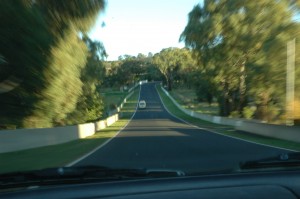 I’m in a craftivist frenzy. Craftivism is a blend of craft and activism. When you put them together you get people like the Knitting Nannas who are campaigning against coal seam gas (aka fracking). After an interval of a couple of years, I’m back on the 1970s ring-pulls. These were ripped from beer and soft drink cans to disappear in to the grass to cut bare feet at barbecues. These days ring-pulls are of a gentler design, and mostly stay put on the can. Mount Panorama, home to wild beer-drinking car-race fans for generations, is still studded with the old style ring-pulls. I pick up a few just about every time I walk up there with Bertie, the black Labrador. It was gorgeous up there tonight. The air was particularly soft; there was a gentle breeze; and the last golden rays were picking out the shapes of the town below. I should have been lapping up the view or looking up into the trees at the crimson and eastern rosellas, but I was scanning the dirt at my feet. The pickings are best after a heavy rain. They get washed out like specks of gold. They go into my pocket, and when I get home, into a jar. I got three in my haul this evening; one had lost its tail. And now I’m mulling over how I’ll use them in this year’s Waste 2 Art exhibition up at the Flannery Centre.
I’m in a craftivist frenzy. Craftivism is a blend of craft and activism. When you put them together you get people like the Knitting Nannas who are campaigning against coal seam gas (aka fracking). After an interval of a couple of years, I’m back on the 1970s ring-pulls. These were ripped from beer and soft drink cans to disappear in to the grass to cut bare feet at barbecues. These days ring-pulls are of a gentler design, and mostly stay put on the can. Mount Panorama, home to wild beer-drinking car-race fans for generations, is still studded with the old style ring-pulls. I pick up a few just about every time I walk up there with Bertie, the black Labrador. It was gorgeous up there tonight. The air was particularly soft; there was a gentle breeze; and the last golden rays were picking out the shapes of the town below. I should have been lapping up the view or looking up into the trees at the crimson and eastern rosellas, but I was scanning the dirt at my feet. The pickings are best after a heavy rain. They get washed out like specks of gold. They go into my pocket, and when I get home, into a jar. I got three in my haul this evening; one had lost its tail. And now I’m mulling over how I’ll use them in this year’s Waste 2 Art exhibition up at the Flannery Centre.
I’m thinking I’ll use the ring-pulls to represent carbon dioxide. It’s carbon dioxide that causes the fizz when a can of soft drink is opened; it’s carbon dioxide that’s emitted when the oil is burned up in those giant V8 engines. And, like the ring pulls of the 1960s and 70s, it hangs around. Some of the carbon dioxide released into the atmosphere over the last two centuries will stay there for thousands of years. Last year was planet earth’s hottest year since we started keeping records; this year is quite likely to be hotter still. So, how do I get my ring-pull collection into a piece of climate change craftivism? Mulling, mulling.

Just a few beers on a hot day. Pic from our local paper, The Western Advocate. Getty Images/Mark Kolbe
This year marks the two hundredth year since Governor Lachlan Macquarie pitched a tent beside the Wambool River while his aide, Captain Henry Antill, declared the place a delightful spot for a town. The bicentenary of white settlement (the river is now known as the Macquarie) will be celebrated in a number of ways, including the naming of 200 “living legends” about town, and the dressing up of 200 cardboard cutouts to represent pioneers and other worthies. In the midst of all this celebration of Important Persons, I feel the need to honour the place itself – this place, as it was and is, with its particular plants and animals and bodies of water and layers of rock. It’s threatened and extinct natives, as well as the newly-arrived sheep and cows, pet dogs and cats. Birds. Insects. All these creatures, barely noticed, with whom we’ve been living. Yesterday, at the first BCCAN meeting for the year, I said I wanted us to collect 200 pictures (photographs, drawings, paintings, specimens) of different local plants and animals and display them somewhere. Big job. Need a committee. See? Frenzy.






